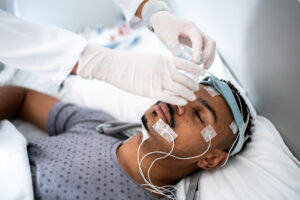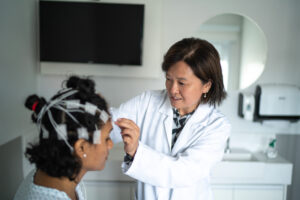What Is a Somnologist?
When a person experiences sleep-related difficulties, their doctor may refer them to a sleep doctor called a somnologist. We explore what a somnologist does, how they diagnose sleep disorders, and how to find a somnologist in your area.
What Does a Somnologist Do?
A somnologist, commonly referred to as a sleep specialist, is a doctor with specialized training and experience in diagnosing and treating sleep disorders. Sleep specialists generally attend a residency or fellowship related to sleep medicine after medical school. They may also earn board certification in sleep medicine.
Sleep medicine is considered a subspecialty, so somnologists generally specialize in a broader medical specialty, as well. Specialties somnologists study may include:
- Internal medicine
- Pulmonary medicine
- Psychiatry
- Pediatrics
- Neurology
- Family medicine
- Ear, nose, throat (otolaryngology)
- Anesthesiology
- Dentistry
Although they are not technically sleep specialists, other medical professionals are also often involved in treating people with sleep disorders. For example, nurses, physician assistants, mental health professionals, and surgeons can primarily work with people experiencing sleep disorders. Similarly, sleep technologists are not doctors, but they work with people who have sleep disorders.
In the U.S., people usually reserve the term “somnologist” for medical doctors that are sleep specialists. However, in Europe, other medical professionals involved in treating people with sleep disorders, such as nurses, technologists, and psychologists, may also be referred to as “somnologists.”
How Somnologists Diagnose Sleep Disorders
Somnologists usually begin to diagnose sleep disorders by asking questions about a person’s medical history and sleep patterns. They may also conduct a physical exam and order sleep testing, when needed.
Often, sleep testing is carried out by sleep technologists. Then, they and the somnologist interpret the results of that testing. Multiple sleep tests are available, and doctors choose which ones to order based on which sleep disorders they think a person might have.

Polysomnography
Polysomnography (PSG) is a test that involves sleeping in a sleep lab while a sleep technologist monitors the person sleeping. This sleep study is often used to diagnose sleep-related breathing disorders, like obstructive sleep apnea, as well as other disorders like narcolepsy.
During polysomnography, a person is connected to devices that monitor various bodily measures. Factors measured during PSG often include stages of sleep, breathing effort, airflow, snoring, carbon dioxide levels, blood oxygen, heart activity, body position, and movement.
Multiple Sleep Latency Test (MSLT)
The multiple sleep latency test is conducted in a lab and identifies the degree of sleepiness a person has by measuring how quickly they fall asleep. The MSLT is often used to diagnose people with narcolepsy or hypersomnia. It is not normally used when a person is suspected of having obstructive sleep apnea or insomnia.
Maintenance of Wakefulness Test (MWT)
The maintenance of wakefulness test is also conducted in a lab and identifies the degree of sleepiness a person has by measuring how long they can stay awake. This test is often used after a person with a sleep disorder like narcolepsy has undergone treatment. If they are able to stay awake longer than they could previously, that suggests the treatment is helping.
Other Sleep Testing
Sometimes sleep specialists decide a person does not require in-lab sleep testing, but they want other types of testing to be done. These types of home testing may include:
- Home sleep apnea testing (HSAT): The HSAT monitors breathing, pulse, and blood oxygen. It is a test a person can wear overnight at home to help determine if they have obstructive sleep apnea.
- Actigraphy: Actigraphy involves wearing a battery-operated device on one’s wrist while sleeping at home. Actigraphy measures movement and light exposure, and can distinguish sleep from wake. It is often used to determine sleep wake patterns.
- Sleep diary: A sleep diary is a written record that lists when a person goes to sleep and wakes up each day, as well as how well they feel they slept.
How to Find a Somnologist Near You
Find a somnologist near you through our find a sleep consultant tool. There are board certified sleep medicine doctors available in sleep clinics across the country. Keep in mind that your health insurance company may require you to obtain a referral from your primary care physician before you can see a sleep specialist.

Still have questions? Ask our community!
Join our Sleep Care Community — a trusted hub of sleep health professionals, product specialists, and people just like you. Whether you need expert sleep advice for your insomnia or you’re searching for the perfect mattress, we’ve got you covered. Get personalized guidance from the experts who know sleep best.
References
1 Sources
-
American Academy of Sleep Medicine. The Path to Sleep Medicine., Retrieved December 13, 2023, from
https://aasm.org/professional-development/choose-sleep/the-path-to-sleep-medicine/




